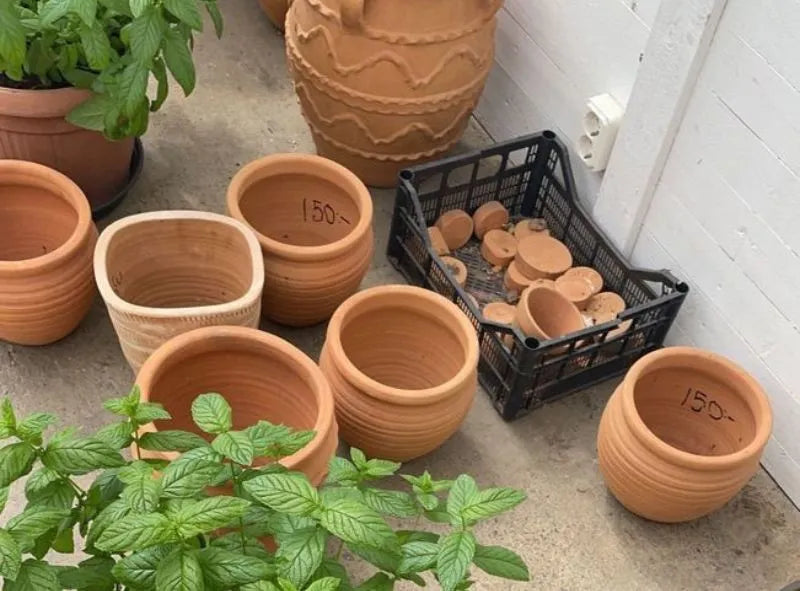When it comes to choosing containers for your indoor plants, it is essential to understand the difference between a pot and a planter . This distinction is not only aesthetic, it also plays a role in the well-being of your plants 🌱💚
Don’t panic, we’re going to explain everything about the differences between these two types of containers and how they can influence the health of your plants.
What is a plant pot?
What is a pot for?
A plant pot is a container designed to hold potting soil and allow a plant to grow . Pots usually have holes in the bottom to allow water to drain , preventing root rot.
They can be made from a variety of materials, such as plastic, clay, terracotta, or biodegradable materials.
Benefits of Plant Pots
- Effective Drainage 👍 Drainage holes allow excess water to escape, preventing root rot.
- Ease of repotting 🪴 pots make repotting easy, providing an optimal environment for plant growth.
- Humidity control 💧 pots allow better management of the humidity of the soil, thus avoiding excess water!
- Promotes root aeration 🌬️ terracotta pots, for example, are porous and allow roots to breathe better, thus promoting healthy growth.
- Stability for plants 🏠 Heavier pots, such as terracotta or ceramic, provide greater stability, which is important for tall plants or those with dense foliage.
What is a cache-pot?
What is a planter used for?
A cache-pot is a decorative container designed to hide a plant pot that is often less aesthetic. Unlike pots, cache-pots do not have drainage holes . Their role is mainly aesthetic , allowing you to vary the style and color without disturbing the plant by repotting it. If you are part of the indecisive team and you tend to change your decor style quite regularly, we recommend cache-pots, which you can change as you wish.
Benefits of Planters
- Aesthetics ✨ Plant pots add a decorative touch to your interior, allowing you to vary the styles. They are available in a wide variety of designs, colors and materials, making it easy to match them to your interior decoration!
- Protection 🪵 they protect surfaces from water splashes and soil. This is especially useful for sensitive surfaces such as wood or textiles.
- Insulation 🪟 Plant pots help maintain the temperature and humidity around the plant, which is especially helpful for certain plants. They can also provide extra protection from cold drafts.
- Ease of movement 🚶 by using a planter, you can easily move your plants without the risk of spilling the soil or damaging the roots. This is particularly practical for heavy or large plants. And again very practical, if you are part of the indecisive team and you tend to constantly change all the elements of place (we do not judge you, we are the same ...).
- Adaptability ❤️🩹 This one combines all the reasons mentioned above! You can change the planter according to the seasons or your current decor, without having to repot your plant, which reduces stress for it.
How to choose between a pot and a cache-pot?
Practical considerations
When choosing between a pot and a planter, it is important to consider the specific needs of your plants . If you have plants that require optimal drainage, opt for pots with drainage holes. For decorative plants or if you want to vary the look without too much manipulation, planters are a great option.
Combine the two
It is quite possible to combine the use of pots and cache-pots . Place your plant in a pot with good drainage, then insert this pot into a more aesthetic cache-pot.
This allows you to benefit from the advantages of both types of containers while maintaining a harmonious decoration. In addition, it makes maintenance easier because you can remove the pot to water the plant without risking dirtying or damaging your interior.
You can also combine practicality and aesthetics with our Paula autonomous pot . Thanks to its micro-porous ceramic inner pot, water slowly seeps directly into the roots for optimal and autonomous hydration. And its outer pot, with its very attractive design (we can say it), will allow you to add a new decorative touch to your living room 💫

Additional tips for caring for potted plants and planters
-
Monitor Moisture : Even though planters don't have drainage holes, it's important to monitor the moisture in the potting soil. Too much water can cause problems, so consider removing the inner pot to check the moisture level regularly.
-
Use saucers : For pots with a drainage hole, consider placing a saucer or tray on the bottom to catch excess water. This can help prevent water damage to your furniture and floors (again, we speak from experience...).
-
Choose breathable materials : for pots, opt for materials such as terracotta or ceramic which allow better aeration of the roots.
-
Avoid standing water : Make sure that water does not stagnate at the bottom of the planter. Too much standing water can lead to root rot problems. Remember to drain excess water regularly.
By choosing the right type of container and using suitable solutions, you can not only upgrade your interior decor, but also ensure the well-being of your favorite plants. 🌿
💌Subscribe to our newsletter to receive exclusive tips and special offers.


